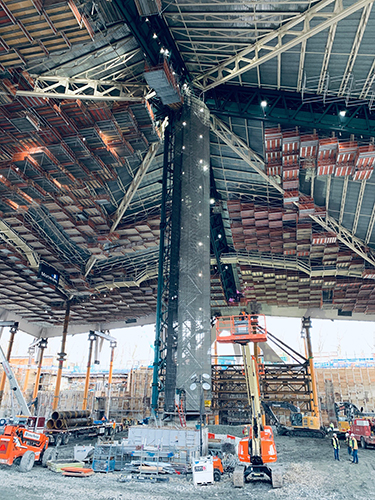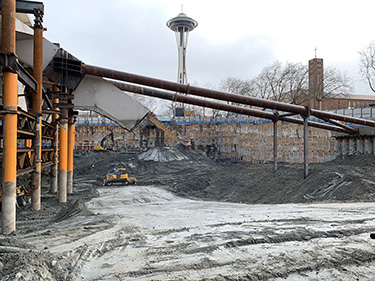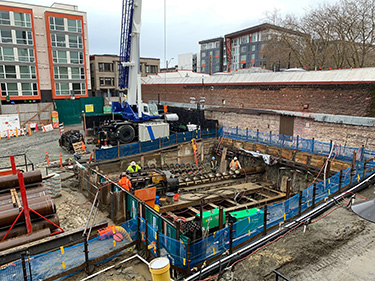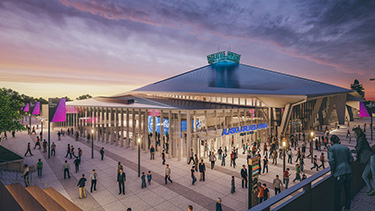|
Subscribe / Renew |
|
|
Contact Us |
|
| ► Subscribe to our Free Weekly Newsletter | |
| home | Welcome, sign in or click here to subscribe. | login |
Construction
| |
January 22, 2020
New arena pit nearly done as roof ‘floats' above on temporary bracing
Real Estate Editor
The landmarked roof of the old KeyArena is now “floating,” and the first foundation work has begun.
The DJC and other media made a site visit yesterday, where excavation to a depth of about 75 feet is nearly complete. Representatives from Oak View Group, contractor Mortenson and project manager CAA Ikon all said the $930 million project is still on schedule to open in the fall of 2021. That's the same time an unnamed new NHL team is expected to debut there.
One name we now know is that of Alaska Airlines, which recently bought the naming rights for the new atrium to go on the south side of the project, facing Thomas Street. (Financial terms weren't announced.)
That 36,000-square-foot structure will appear relatively late in the construction (i.e. 2021), since it's entirely above grade and connects to the plaza that wraps around the site to First Avenue North. It'll also be the arena's new main entrance — a change from the old configuration.
Alaska Airlines Atrium will also sit on top of the new 190-foot-long loading and access tunnel. James W. Fowler Co. recently began boring in the parking lot south of the landmarked Pottery Northwest (aka the Bressi Garage). It'll be about 75 feet deep where it enters the new arena. The dimensions — about 24 feet wide, 18 feet high — will allow two tour buses or tractor-trailer rigs to pass in opposite directions, to expedite the staging of sports and entertainment events.
That tunnel should be done this fall, said Mortenson. Then it'll be used for construction access and to route the utilities for HVAC and the like.
Excavation in the main pit is about three-quarters done. When completed later this spring, about 600,000 cubic yards will have been removed.
“We've been making great progress,” said Ken Johnsen of OVG. “The weather has cooperated.”
Of the roof overhead, now completely supported by temporary bracing, “It's in that floating state,” Johnsen said. He compared it to a space ship in Star Wars — appropriate given the Space Age original design by Paul Thiry for the 1962 World's Fair.
Detaching and preserving a 44 million-pound roof has been a unique proposition. Neither Johnsen nor Greg Huber of Mortenson could recall any precedent. “It's something that we've never quite tackled,” said Huber.
The pit, a warren of activity, still smells of mud and acetylene welding. All the original Y-shaped supports have been snipped.
As the concrete foundation is poured — staring in the northeast corner, near SIFF Film Center — those columns will be reattached to the new foundation. That process will proceed clockwise from the northeast corner, where the maximum excavation depth has been reached.
The most prominent of the temporary bracing supports is the so-called “kickstand” to the south, which reaches all the way to Thomas Street.
Extensive scaffolding allows workers to access the roof, which is still in good shape according to Huber. Even so, it'll need to support more hanging weight in the future — for TV screens, etc. — and, he added, “It's all about the upgrade for seismic.”
The old arena had 400,000 square feet, and the new will have around 750,000. Of that, about 500,000 will be below grade. Add in the old structured parking garage south of Thomas, plus improvements to the plaza, and the whole project totals over 1 million square feet. When all is finished, the new arena bowl will be about 53 feet below grade, with up to 18,600 seats.
The team includes Populous of Kansas City, Missouri (architect), Malcom Drilling, JR Hayes (excavation), Rhine Demolition, Rockwell Group (design consultant), Thornton Tomasetti and Hart Crowser.
Elliott Veazey of CAA Ikon said that the naming rights for new arena aren't being auctioned off in a formal process. Rather, there are ongoing discussions among OVG, NHL Seattle and interested parties. CAA Ikon does a lot of stadiums, he said; sometimes the naming rights sell early, and sometimes they sell late.
If and when the NBA commits to a new franchise in Seattle, that would greatly increase the value of said rights. But there's no guarantee of a new NBA expansion team here before the arena opens and the naming rights are sold.
T-Mobile and CenturyLink are presumably not in the running, because they already have their two stadiums in Sodo. And Alaska Airlines is probably unlikely to spend more on the new arena, since it has the arena at Hec Edmundson Pavilion.
Among prominent local companies, Amazon, Boeing, Starbucks and Microsoft have never slapped their brand on a sports and events arena.
ESPN estimates that such deals can run from $600,000 per year in a smaller market like Jacksonville to $6.5 million in Dallas (for American Airlines Center). Here, CenturyLink recently extended its deal for the Seahawks' home venue through 2033 for $162.7 million — or about $10.8 million per year. T-Mobile's 25-year deal, at $87.5 million, works out to $3.5 million per year
KeyBank's old deal, which expired in 2010, was worth about $1 million per year. The Sonics played their last game here in 2008.
Brian Miller can be
reached by email at brian.miller@djc.com or by phone at (206) 219-6517.






